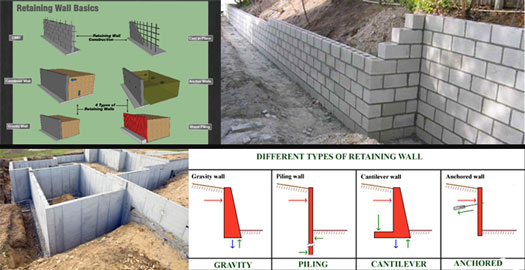
Foundation walls are the walls that are typically seen in the basement of houses. The bottom wall is on a footing with a slab on grade attached to it. The top of the wall is tied into the first-floor framing. Sometimes in a garage or in different type of conditions, the wall may be tied into a higher slab on grade. The wall retains the soil behind it, which exerts a horizontal force on the wall away from the soil. This typically pushes the bottom of the wall and the top of the wall outward away from the soil.
In a foundation wall, the force at the bottom of the wall is resisted by the footing and the slab on grade and force at the top of the wall is resisted by the floor framing. When you have a condition where the top of the wall is not braced, this becomes a retaining wall. There is nothing to resist the force at the top of the wall. Many times, retaining walls are freestanding exterior structures separating differences in grade. There are many ways to construct a retaining wall, such as gravity walls with large footings, Geogrid tieback, other types of tiebacks, etc. The common theme of all of these types of retaining walls is that they are designed specifically to be self-supporting and not rotate or tip over outwards. The typical method of failure of a retaining wall is leaning away from the soil and rotating outward. This condition does not occur at foundation walls provided the top tie is intact and has not failed, as the top tie will restrain the wall.
We have seen many conditions where a typical foundation wall is constructed and there is a grade differential that was not accounted for in the design and construction, which causes a wall constructed as a foundation wall to behave as a retaining wall. This is typically seen where the first or garage level is a slab on grade and the exterior grade drops lower, creating a grade differential between exterior and interior. Once this grade differential is over 1’-2’, if the top of the wall is not properly tied, or the tie fails, you will see outward rotation of the wall. Sometimes this can push the bottom of the wood framing outward, also. Provided that the rotation is minor to moderate, there are remedies that can correct the condition in place. If the condition becomes severe, the wall may need to be removed and rebuilt in its entirety.
